Ultra-soft milk bread rolls using the tangzhong method. These Asian-style dinner rolls stay fluffy for days. Perfect for sliders, sandwiches, or holiday meals!
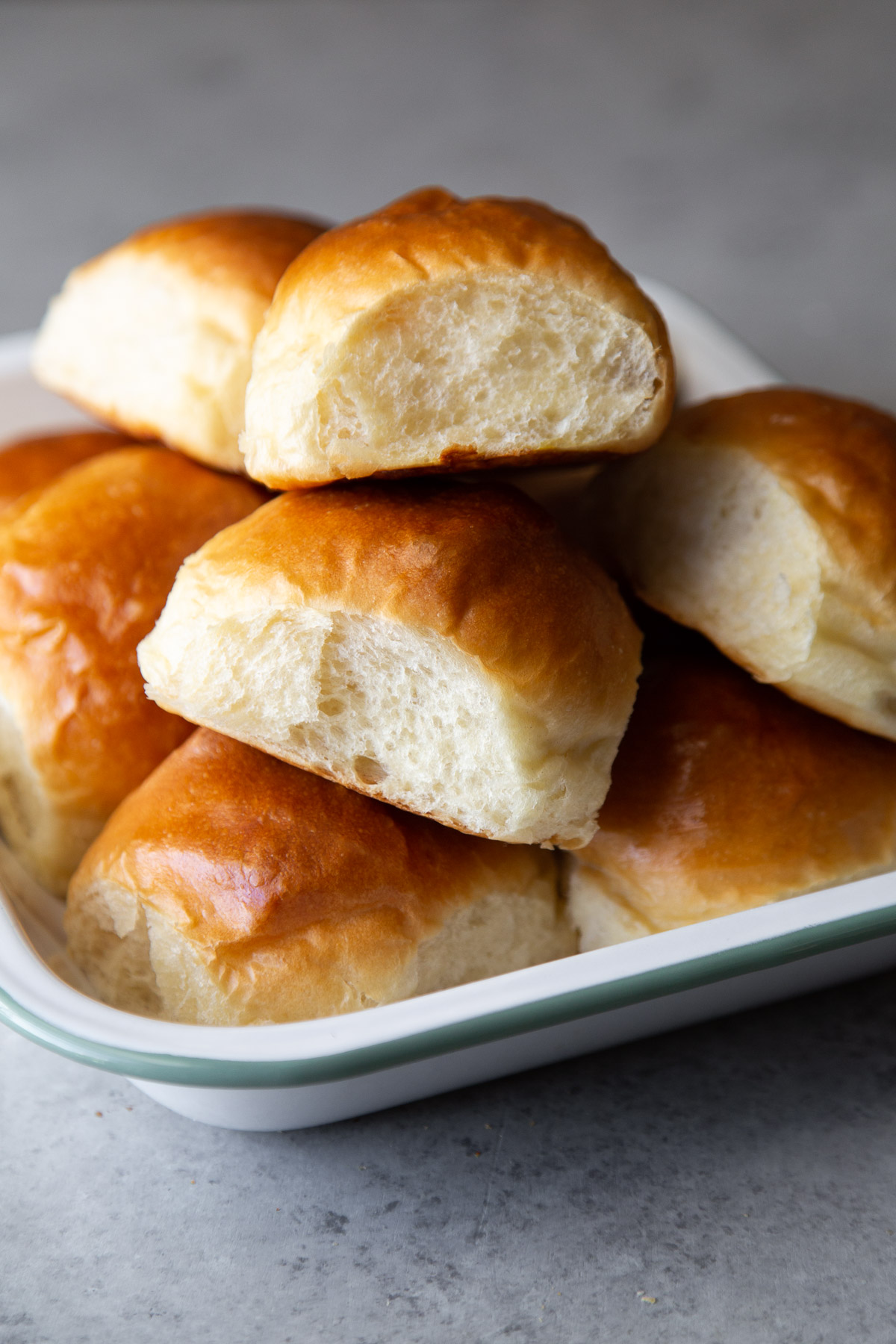
These are the softest, most pillowy dinner rolls you’ll ever make—and they stay that way for days. The secret? A Japanese technique called tangzhong (or water roux) that I learned during my pastry training and have perfected over years of baking.
One bite of these cloud-like milk bread rolls and you’ll understand why this method has taken the baking world by storm. The interior is impossibly tender with delicate, pull-apart layers. The golden exterior has just enough structure to hold your favorite sandwich fillings or soak up every drop of gravy at your holiday table.
Unlike typical dinner rolls that turn hard and stale by the next day, these milk bread rolls maintain their signature softness for 3-4 days thanks to the tangzhong starter. It’s the same technique behind viral Hokkaido milk bread, and once you try it, you’ll never go back to regular dinner rolls.
Brush them with melted butter and finish with flaky Maldon sea salt while they’re still hot from the oven. Trust me on this—it takes them from delicious to absolutely irresistible.
Why This Recipe Works
Professional baker insight: After nearly 20 years working in restaurant kitchens and bakeries, I can tell you that the tangzhong method is a game-changer for home bakers. Here’s why this recipe delivers consistent, bakery-quality results:
The Tangzhong Advantage
- Science-backed softness: Cooking flour with liquid creates a gel that traps moisture in the dough, resulting in rolls that stay soft 3x longer than traditional recipes
- Improved texture: The pre-gelatinized starches create that signature fluffy, almost cotton-like crumb structure
- Beginner-friendly: This technique is more forgiving than traditional bread recipes—the dough is easier to handle and harder to overbake
Precise Measurements Matter As a pastry chef, I always measure by weight. Bread baking is predictable science when measured correctly. You’ll need just two essential tools: a kitchen scale and an instant-read thermometer. These eliminate the guesswork that causes most bread failures.
Ingredients
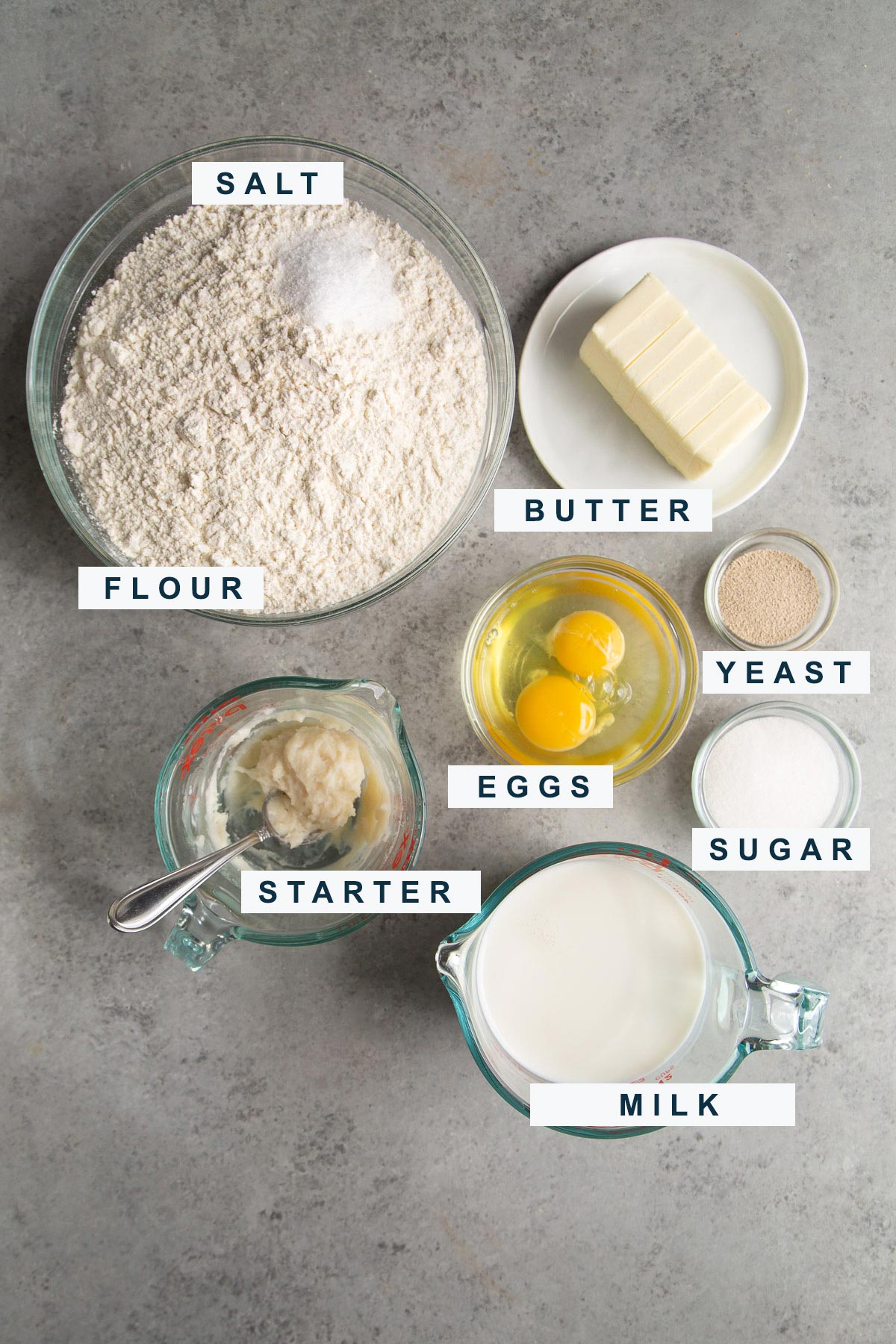
These dinner bread rolls are made using your standard yeast dough ingredients with the exception of a dough starter or water roux. Here are notes regarding key ingredients and substitutions:
Flour: Measure by weight for best results (715g). If measuring by volume, use the spoon and level method. Both bread flour and all-purpose flour work beautifully—bread flour gives slightly more structure, all-purpose yields a softer crumb.
Yeast: Active dry yeast is my preference. The key is temperature: liquids should be 95-120°F to activate the yeast properly. Anything over 140°F kills the yeast. This is the #1 reason bread recipes fail—use a thermometer to eliminate the guesswork. Check my baking with yeast tutorial for complete guidance.
Milk: Whole milk provides the richest flavor and softest texture. You can substitute 2% milk or non-dairy alternatives (oat milk works particularly well), but whole milk delivers the best results.
Butter: Use softened unsalted butter so you can control the salt level. The butter adds richness and helps create that tender crumb.
Salt: I use Diamond Crystal Kosher Salt, which is less salty and dissolves faster than Morton. If using Morton or table salt, reduce the amount by half (see recipe notes for exact measurements).
Sugar: Just enough to feed the yeast and add subtle sweetness. These are savory-leaning rolls. Swap in honey or agave if you prefer.
Dough Starter: Tangzhong Water Roux
Tangzhong is a cooked flour paste (water roux) that originated in Asia and revolutionized soft bread baking. You simply cook flour with milk and water until it forms a thick, smooth paste—similar to the consistency of mashed potatoes.
This 2-minute step does something magical: it gelatinizes the starches in the flour, allowing the dough to absorb and retain significantly more liquid. The result? Bread that’s softer, fluffier, and stays fresh longer.
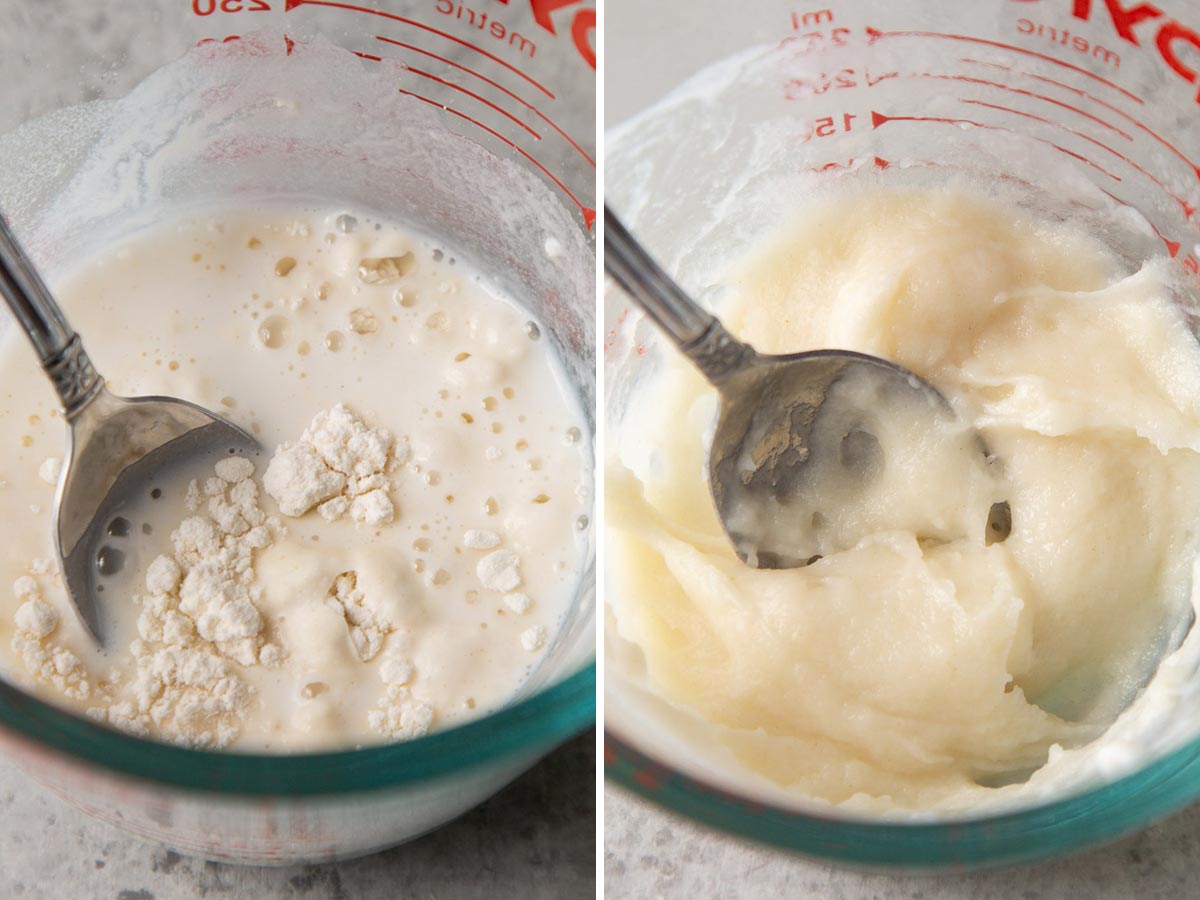
Quick tangzhong tutorial:
- Mix 2 tablespoons flour + 2 tablespoons milk + 2 tablespoons water
- Microwave in 30-second intervals, stirring between, until thick and smooth (about 60-90 seconds total)
- Add to your bread dough—that’s it!
This is the same technique used in Japanese milk bread (Hokkaido milk bread) and other Asian-style breads famous for their incredible softness.
Proofing Yeast Dough
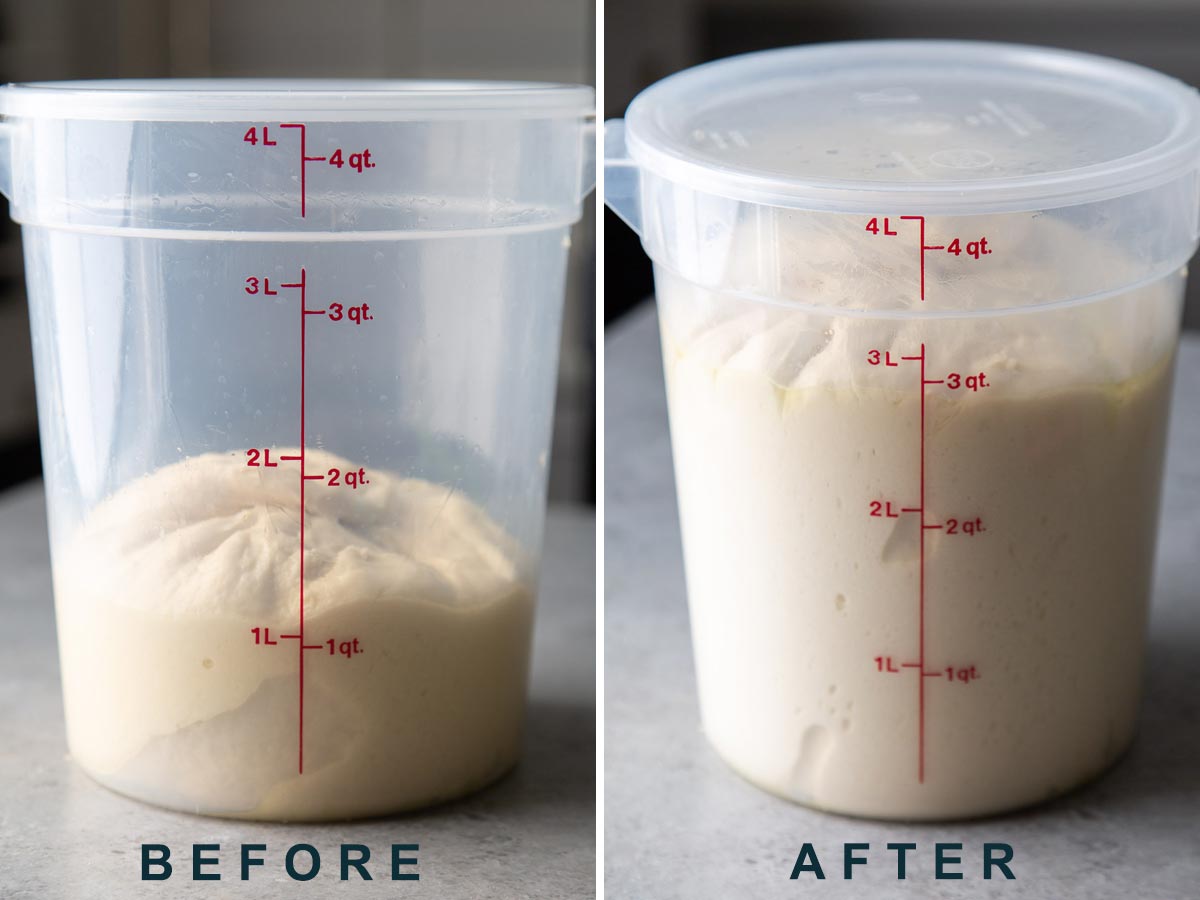
Knead together the soft dough. Place in an oiled container or bowl with lid. Keep in a warm place away from direct sunlight. Allow the dough to rest and rise.
As evident in the image above, this milk bread dough will nearly triple in volume!
Yeast is easy to work with as long as you have the right tools. It’s important to use a kitchen thermometer to measure the temperature of your liquids.
One of the biggest reasons breads fail is due to problems with the yeast.
Most of the time, the liquids aren’t warm enough to activate the yeast, or the liquids are so hot that it kills the yeast. A kitchen thermometer saves you from guessing.
When working with active dry yeast, it’s best to work with liquids between 95- 120 degrees F. Anything over 140 degrees F is too hot. High temperature will kill the yeast.
Portion and Shape Bread Rolls
For best results, use a digital kitchen scale to portion out the milk dough. The recipe makes 24 dinner rolls.
The images below show a dozen rolls baked in a 9×13 baking pan. You will need a 18×13 baking sheet or baking pan to bake all 24 rolls together.
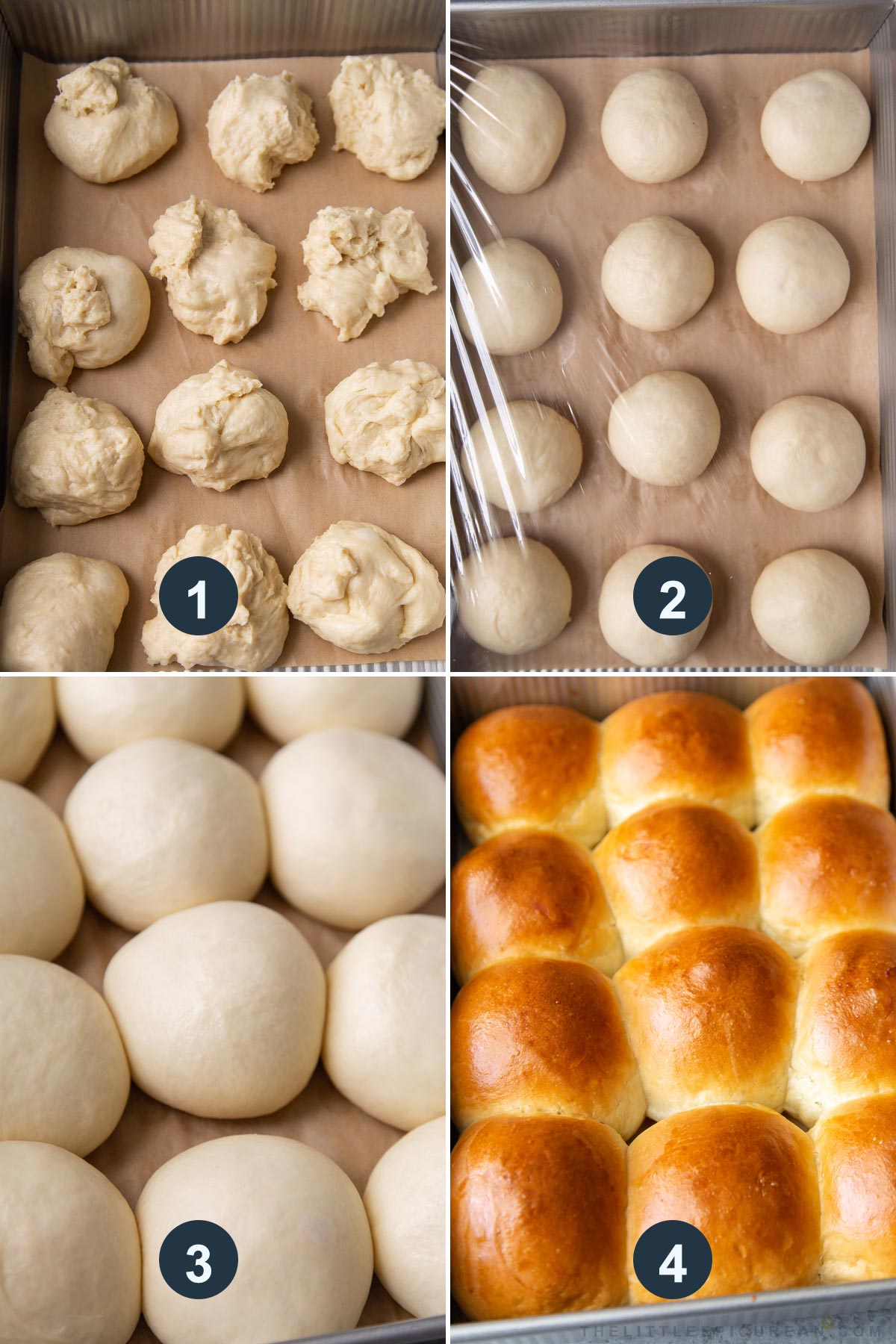
- Divide dough in 24 equal portions using a kitchen scale.
- Roll dough into a tight rough ball. Cover shaped dough. Let rise in a warm area away from direct sunlight.
- Brush egg wash over proofed dough. Dough will puff and expand during proofing/resting period. will expand and puff up.
- Bake rolls until golden. Cool slightly. Serve milk bread rolls warm.
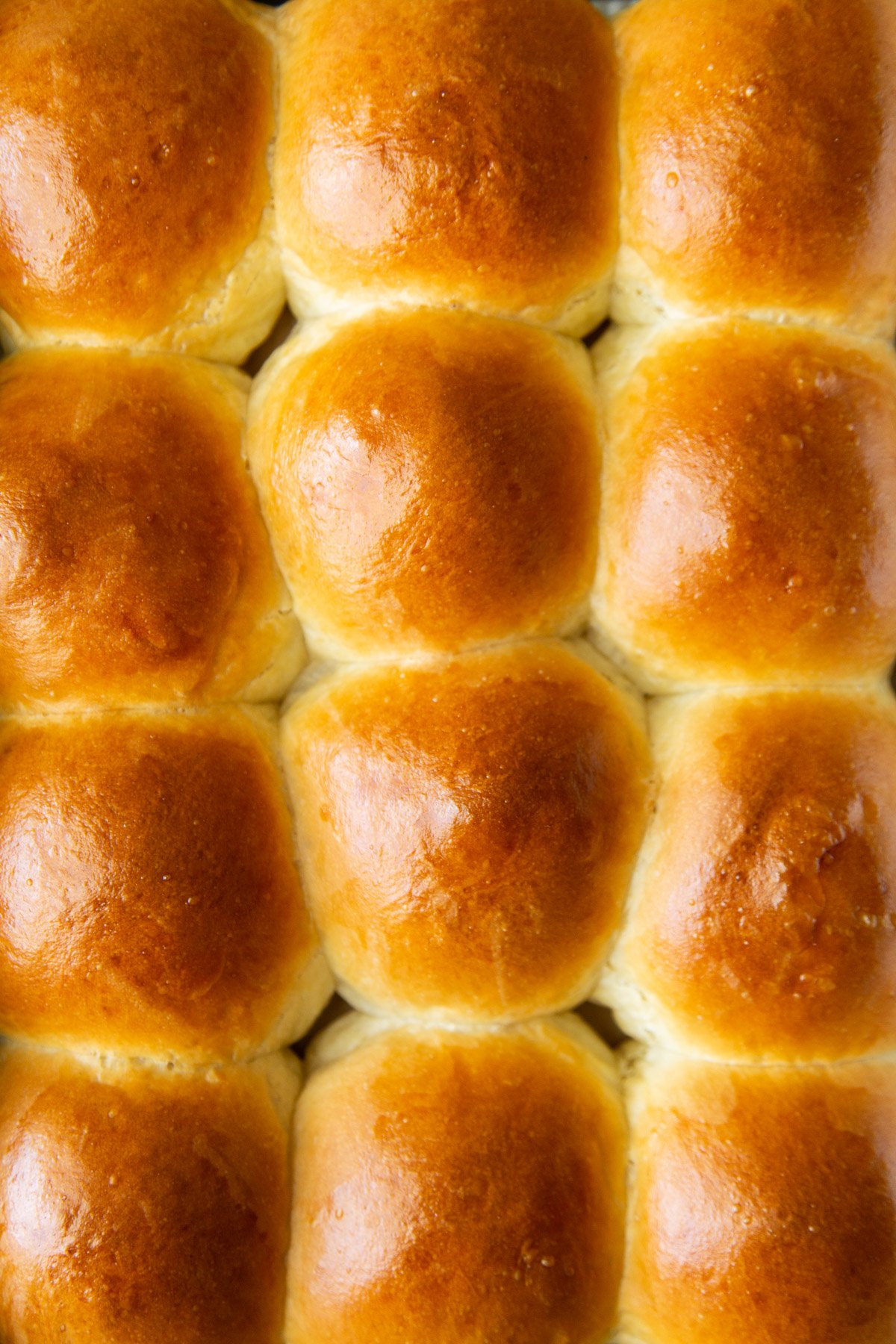
Serving Suggestions
These versatile milk bread rolls shine in countless ways:
- Holiday Tables: Perfect alongside Easter ham, Thanksgiving turkey, or Christmas roast beef. The soft texture is ideal for soaking up gravies and sauces.
- Slider Station: Slice horizontally for shoyu pulled pork sliders, ricotta meatball sandwiches, or mini deli sandwiches piled high with your favorite meats and cheeses.
- Sauce Sopper: Serve alongside spaghetti, Asian braised beef, or any dish with delicious sauce you don’t want to waste.
- Breakfast Rolls: Split and toast, then spread with butter and jam for a simple, satisfying breakfast.
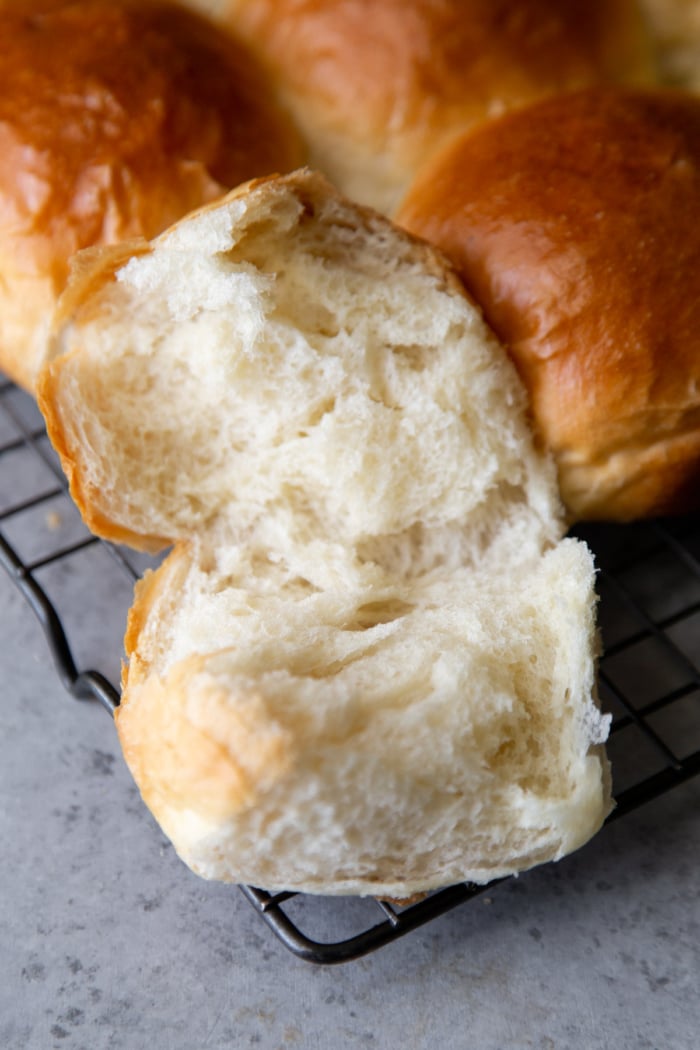
Storage & Make-Ahead Tips
Room Temperature: Store in an airtight container for up to 4 days. The tangzhong method keeps them soft without refrigeration.
Freezing: Freeze baked rolls for up to 3 months. Thaw at room temperature and warm in a 300°F oven for 5-7 minutes.
Make-Ahead Option: After shaping rolls, cover and refrigerate overnight (up to 12 hours). Bring to room temperature (about 30-45 minutes) before applying egg wash and baking.
Reheating: Warm rolls wrapped in foil at 300°F for 8-10 minutes, or microwave individual rolls for 10-15 seconds.
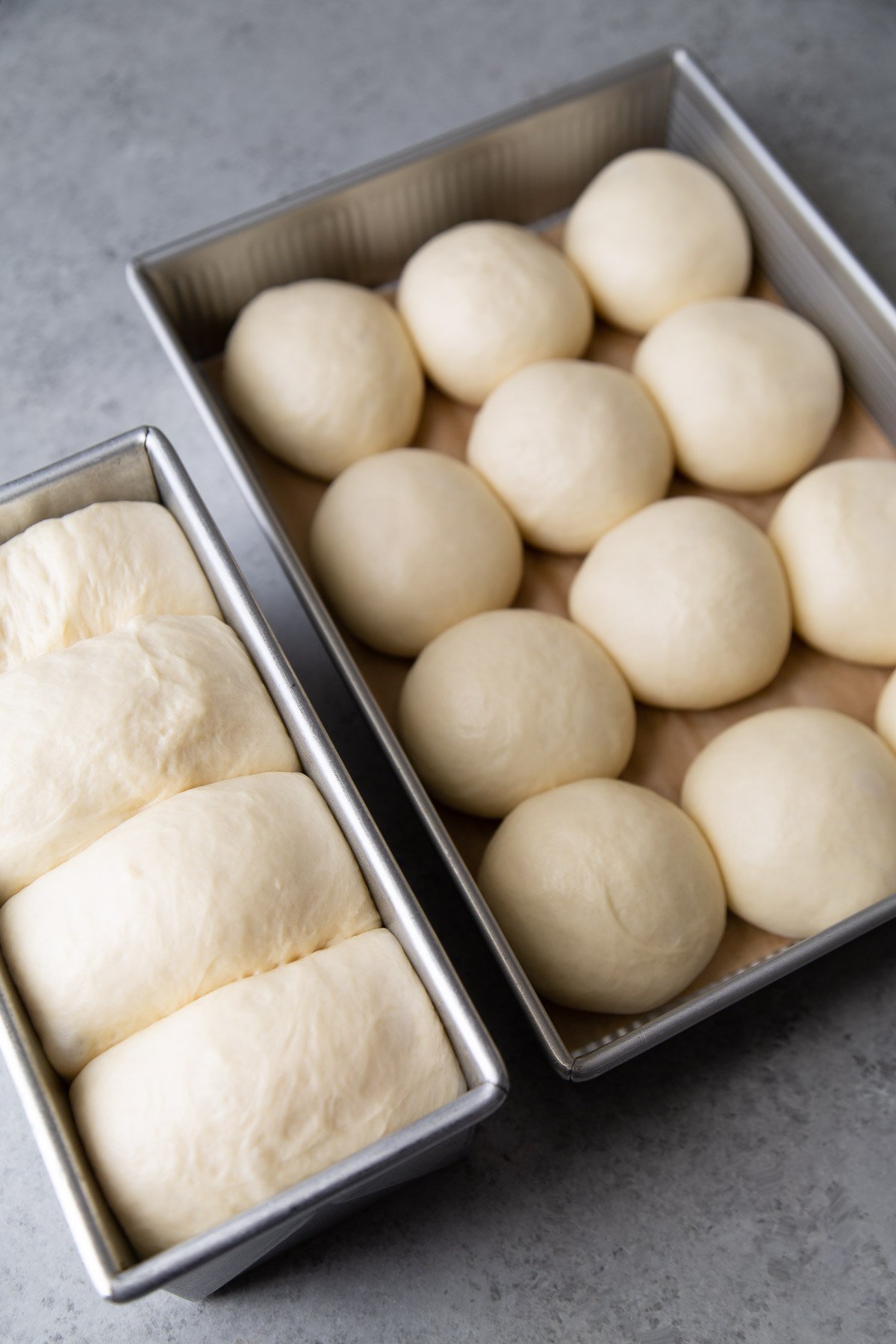
Recipe Variations
This recipe makes 24 dinner rolls. Asides from rolls, you may use the dough to shape other breads. Here are some options:
- 12 dinner rolls + one 9×4-inch pullman loaf (or one 9x-5-inch sandwich loaf)
- 12 hot dog buns
- two full-size loaves
- Slider buns (makes 32 smaller rolls at 35 grams each)
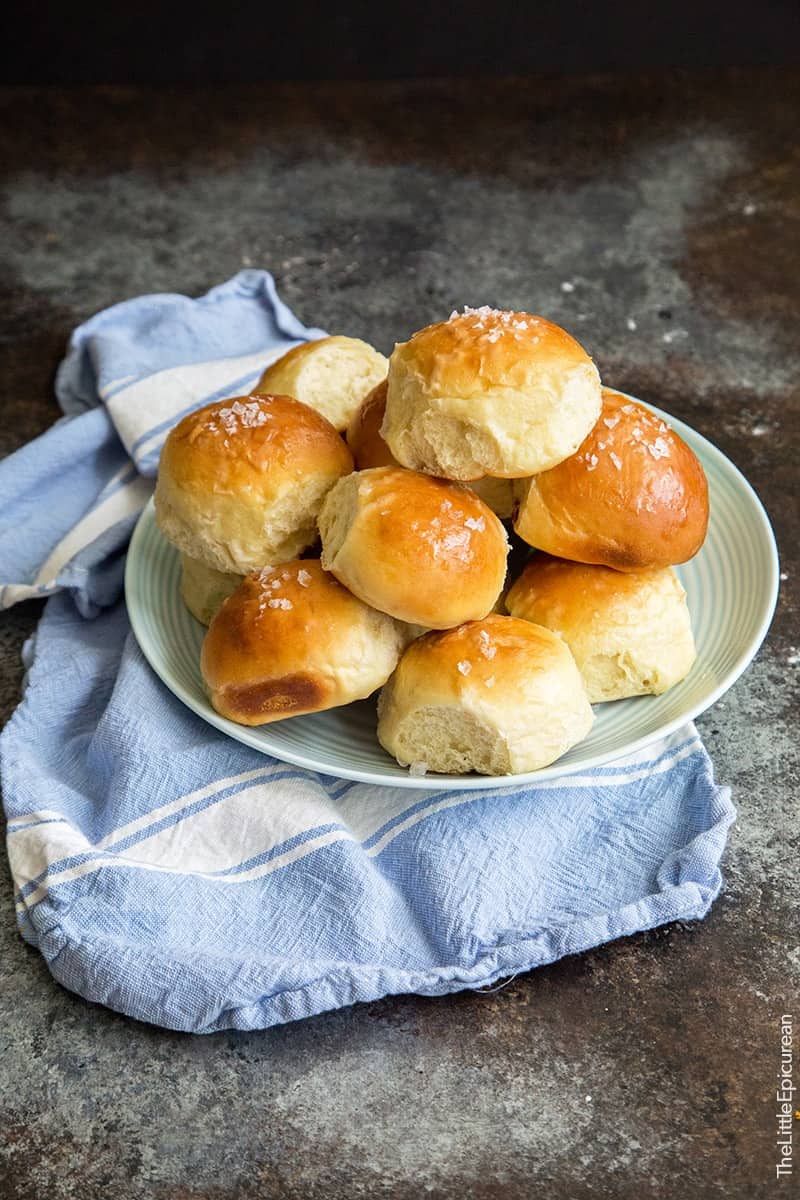
FAQ + Troubleshooting
Yes, use the same amount. Skip the proofing step and add instant yeast directly to the flour mixture. Mix the warmed milk and tangzhong, then proceed with the recipe.
Three possible reasons. 1) The yeast probably wasn’t activated properly. Check your liquid temperature with a thermometer—it must be 95-120°F. 2) Also ensure your yeast isn’t expired. 3) Overworked dough can result in tough dough. Allow overworked dough time to rest and proof properly.
Volume measurements (cups) can vary by 20-30% depending on how you scoop flour. Weight measurements are consistent every time, ensuring reliable results. Once you start weighing ingredients, you’ll never go back.
Your oven temperature may run hot, or rolls were too close to the top heating element. Cover with foil during the last 5-7 minutes of baking, or move the rack to a lower position.
More Dinner Roll Recipes
- Pumpkin Bread Rolls
- Pandesal (Filipino Bread Rolls)
- Black Pepper Cheddar Beer Bread
Milk Bread Rolls

Ingredients
Starter:
- 2 Tablespoons Bread flour, or all-purpose flour
- 2 Tablespoons Whole Milk
- 2 Tablespoons Water
Dough:
- 1 ¾ cups Whole Milk
- 3 Tablespoons Granulated sugar
- 1 Tablespoon Active dry yeast
- 2 Large eggs, Room temp, lightly whisked
- 5 ½ cups Bread flour, (715 g) or all-purpose flour
- ½ cup Unsalted butter, (113 g), softened, room temp
- 1 ½ teaspoons Kosher salt
Egg Wash:
- 1 Large egg
- 1 Tablespoon Water, or whole milk
- Pinch Kosher salt
Instructions
Starter:
- In a microwave-safe bowl, mix together flour, milk and water. Microwave for 30 seconds. Stir. Microwave for another 30 seconds. Stir. The mixture should be smooth with the consistency of mashed potatoes. If mixture is not smooth, microwave for another 15-20 seconds until desired consistency is achieved.
- Transfer mixture to a bowl of stand mixer. Set aside while you prepare dough.
Dough:
- Place milk and sugar in a large microwave safe container. Microwave for 90 seconds. Stir until sugar has dissolved.
- Pour milk mixture into the same stand mixer bowl with the starter. Add yeast and stir to combine. Let mixture sit for 7 minutes to activate yeast. The mixture should be bubbly and fragrant.
- Stir in eggs. Add half of flour. Attached dough hook to stand mixer. Knead of low speed for 3 minutes until dough starts to form.
- With the mixer running, add butter one tablespoon at a time. Stop mixer and add remaining flour along with salt.
- Knead on low speed until flour has been incorporated, about 5 minutes. Dough will be wet and tacky. Turn off mixer and remove hook attachment. Cover dough and let sit for 10 minutes.
- Rested dough will appear smoother. Re-attach dough hook to mixture. Knead on medium speed for 3 minutes until dough starts to pull away from the sides of the bowl. *Don’t be tempted to add more flour. Dough will be a little tacky, but easily scrapes off the bowl.
- Transfer dough to an oil bowl or container. Cover dough. Allow to rest at room temperature for 30 minutes until dough has doubled in volume.
- Punch down risen dough. Transfer to a clean work surface. Divide dough in 24 equal parts. Roll into 24 balls. Place 12 rolls each in two 9×13-inch baking dish. Or place all 24 rolls in a large 18×13-inch baking pan.
- Cover bread rolls. Rest for 30-45 minutes until rolls have puffed up and nearly doubled in volume. Preheat oven to 350℉ while dough rests.
Egg Wash:
- Whisk together egg, water, and salt until smooth.
Baking:
- Brush egg wash over risen bread rolls. Bake for 22-25 minutes until bread is golden brown on top and has an internal temperature of at least 190℉. Allow to slightly cool in pan.
- If desired, brush bread rolls with melted butter and sprinkle sea flakes on top. Serve bread warm.
Notes
- * I used a standard half sheet baking pan (18×13-inches)
Nutrition
Nutrition information is automatically calculated, so should only be used as an approximation.
 Like this recipe? Rate & comment below!
Like this recipe? Rate & comment below!


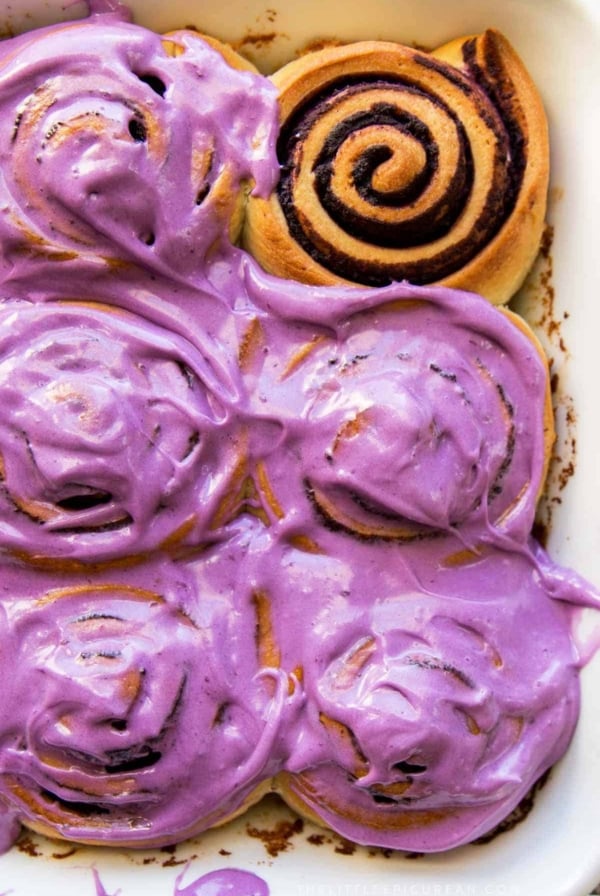
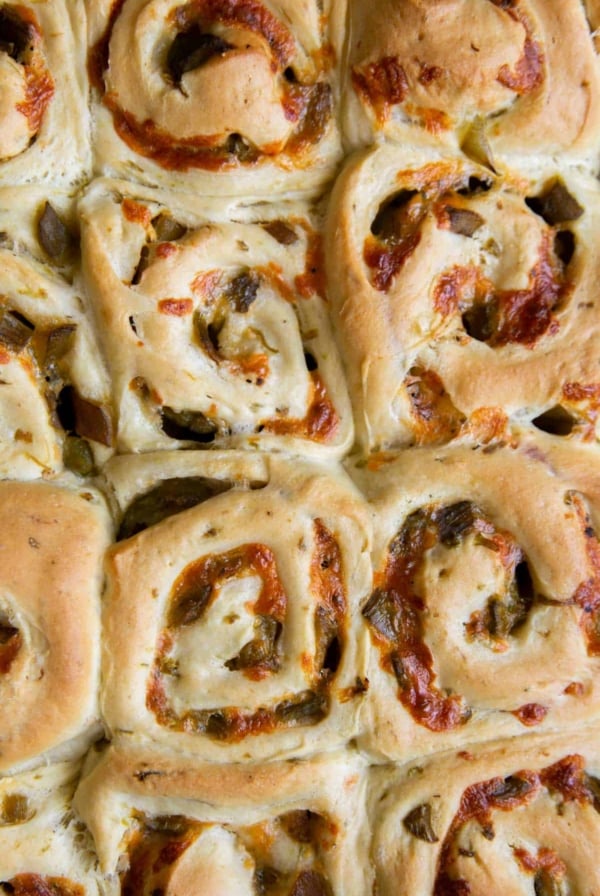





I love this recipe! The rolls are tasty and make a great little snack with a little butter. I also use the rolls to make and freeze breakfast sandwiches. Thanks for a delicious recipe!
I tried this recipe yesterday. It turned out tasty.
Will definitely try these!! Tried other dinner roll recipes but I wasnt happy with the results. Have become a fabmn of yours since your pandesal recipe was really very good. Baked it twice and both cane out wonderful… hoping these rolls will come out good.
Can you make this dough a day ahead of time and refrigerate it before baking?
Yes, roll the dough into balls and then refrigerate it overnight (up to 12 hours). Bring it to room temperature before baking.
Hi I just baked these! They are absolutely delicious! But the top of the bread rolls came out a little hard, is that how it’s supposed to be? Or are they supposed to be ultra soft? the only thing i can think of is maybe over working the dough slightly? not sure but they tasted fantastic! thank you !!!
Thanks for trying out the recipe! Perhaps the heat from the top of the oven is a little warmer than the middle. Or, the rolls were too close to the rack above it? That could also radiate extra heat. Next time, you can also cover the rolls with foil towards the end of baking to make sure the tops of the bread don’t overcook. I hope that helps!
This looks absolutely fantastic. I wish I could pull a roll from my screen.
I think you are offically the queen of breads, these look SO perfect!!